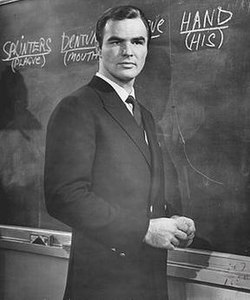Synopsis
Reynolds stars as police lieutenant John Hawk, a full-blooded Iroquois working the streets of New York City as a special detective for the city's District Attorney's office. Hawk is assisted by partner Dan Carter (played by Wayne Grice). Hawk and Carter try to solve various serious crimes such as murder and arson, as well as cases involving organized crime. While facing the brutal, dangerous life of a New York City detective, Hawk is also subjected to discrimination and racism, both on the streets and in the office, due to his native heritage and ancestry.
Many of the scenes were filmed on location in New York City, with some interior scenes filmed at the Filmways Studios in East Harlem.
The series co-stars Bruce Glover as Assistant D.A. Murray Slaken, and Leon Janney as Assistant D.A. Ed Gorton.
Notable guest stars who appear in the series include Gene Hackman, Martin Sheen, Robert Duvall, Diana Muldaur, Scott Glenn, Diane Baker, James Best, Bert Convy, Elizabeth Ashley, Kim Hunter and Lou Antonio.
While not a full-blooded Native American like his character, Reynolds claimed to have some Cherokee blood from his father's side. [1]
Production
The show was announced in June 1966. ABC made a commitment for 17 episodes. The lead role was given to Reynolds who had some Native American ancestry himself and played Native Americans in Gunsmoke and in Navajo Joe . [2] [3]
"I wanted the Indian thing to come naturally", said Reynolds. [3]
"The emphasis will be on how cops function at night", said producer Paul Bogart. "The people who come out at night would astonish you. They're the weirdos of all time." [4]
A representative of ABC said "it won't be another Naked City where they want to know why the killer pulled the trigger. Hawk won't answer that question." [4]
"We're not going for the psychological approach", said Reynolds. "We're an action adventure show. It's fast paced the music is all brass there's a lot of cutting." [5]
"Hawk is quite a character", said Reynolds. "He's very hostile. I'm hostile too. I don't know why." [4]
Reynolds says his performance was inspired by Kirk Douglas in Detective Story and John Garfield. "Tough and hard... I play Hawk as a catalyst. And how things affect me." [3]
"We're placing no special emphasis on the fact that Hawk is an Indian", said Reynolds. "I'm not running around in moccasins or anything like that." [5]
Reynolds added,"Having been in two TV series... where I hold the horse for someone else this feels great. But I'm not going to fall into the trap of thinking this is my one big chance and if I blow it I’m finished. I've had so many disappointments over the years that I've made up my mind: if it doesn't go it's the audience's fault, not mine." [4]
Reynolds says Hawk was originally meant to wear knives on his sleeves but he got that changed feeling it was too gimmicky. [4]
The show was shot on location in New York. [6]
"I do all the stunts because I can do them better than anyone else", said Reynolds. [3]
This page is based on this
Wikipedia article Text is available under the
CC BY-SA 4.0 license; additional terms may apply.
Images, videos and audio are available under their respective licenses.
